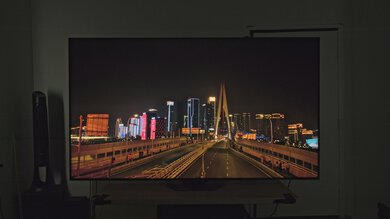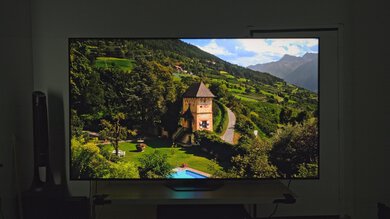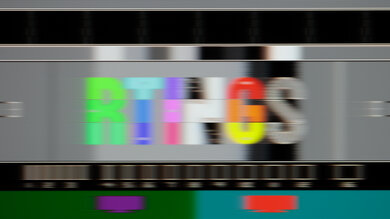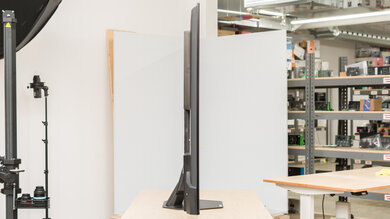The Hisense 75U8N is a mid-range TV released in 2024 and replaces the 75-inch Hisense U8/U8K from 2023. What makes this size option unique is that it uses an ADS Pro panel instead of the VA panel found in all other sizes of the TV, which is something Hisense has done with the 75-inch models in their entire ULED lineup. Since it uses a different panel, it's the odd man out in the U8N lineup, but it still has the exact same features. You still get local dimming, Dolby Vision, ATSC 3.0, Wi-Fi 6E, HDMI 2.1 bandwidth on two ports for up to 4k @ 144Hz gaming, and VRR support. Like the other sizes, it uses the popular Google TV interface, which is loaded with apps and has smart features like voice control. It comes equipped with the same built-in 50W 2.1.2 channel speaker system as the other sizes. The U8N is available in five different sizes: 55-inch, 65-inch, 75-inch, 85-inch, and a massive 100-inch model. This review is only valid for the 75-inch model, but we also reviewed the sizes with a VA panel.
Our Verdict
The Hisense 75U8N is very good for a variety of usages. It's well suited for a bright room thanks to its superb SDR brightness, but it does struggle more with reducing the intensity of direct reflections, so it's best to avoid placing the TV opposite a lamp or window. It's a solid option for a home theater, with effective local dimming for deep blacks, vibrant colors, good image processing, and bright highlights in HDR content. It's a very good gaming TV too, with very low input lag and modern gaming features, but its pixel transitions are a bit slow, so motion isn't as crisp as it could be. The TV has a wider viewing angle than many other LED TVs, so it's decent for watching TV with a few friends.
Excellent HDR brightness for impactful highlights.
Superb SDR brightness means it overcomes glare from indirect lighting.
Good upscaling and very good low-quality content smoothing.
Colors are vibrant, lifelike, and bright.
Deep blacks with minimal blooming when local dimming is enabled.
Worse contrast and dimmer overall than the other sizes of the TV.
Direct reflections are a bit distracting.
Slower pixel transitions in PC/Game Mode leads to blur behind fast motion.
The Hisense 75U8N is very good for a home theater. It has great black levels with local dimming enabled, so you get deep blacks with minimal blooming around highlights, albeit not as deep as the other size options. You also get vibrant and mostly accurate colors that are sure to impress, and its great HDR brightness means highlights really pop out in HDR content. However, the brightness of HDR content is a bit inaccurate, so it doesn't do the best job following the filmmaker's intent in that regard. Fortunately, it does a good job upscaling and a very good job clearing up artifacts in highly compressed content, so it's a good option when the quality of your content isn't ideal. There's a bit of noticeable stutter during slow panning shots, but since the TV's response time isn't the fastest, most people won't notice it.
Excellent HDR brightness for impactful highlights.
Good upscaling and very good low-quality content smoothing.
Colors are vibrant, lifelike, and bright.
Deep blacks with minimal blooming when local dimming is enabled.
Worse contrast and dimmer overall than the other sizes of the TV.
The Hisense 75U8N is excellent for a bright room. It's a seriously bright TV in SDR, so it easily overcomes glare from indirect sources of light. However, it only does an okay job reducing the intensity of direct reflections, so you still see apparent reflections if you have a lamp or window opposite the screen. A major upside is that it barely loses color vibrancy, and blacks stay deep and impressive in a room with ambient lighting, so you enjoy a similarly impressive image as you do in a dark room.
Superb SDR brightness means it overcomes glare from indirect lighting.
Colors are vibrant, lifelike, and bright.
Blacks stay deep and colors stay vibrant in a bright room.
Worse contrast and dimmer overall than the other sizes of the TV.
Direct reflections are a bit distracting.
The Hisense 75U8N is great for watching sports. It's a great option for a sunny afternoon since its SDR brightness easily makes it overcome glare from indirect light sources, although it struggles more if you have a window or lamp opposite the screen since its direct reflection handling is only okay. Colors in your favorite sports really stand out due to the TV's great overall color performance, and you get solid overall image processing that helps upscale and smooth out artifacts in low resolution and heavily compressed streams and broadcasts. Its pixel transitions are fast enough that you won't be distracted by an overly blurry image, but it's only okay gray uniformity means there's some dirty screen effect in the middle of the screen when watching sports like hockey that have large areas of uniform color. The TV's viewing angle is fairly wide for an LED model, so it's a decent option for watching the game with a small group of friends.
Superb SDR brightness means it overcomes glare from indirect lighting.
Good upscaling and very good low-quality content smoothing.
Colors are vibrant, lifelike, and bright.
Worse contrast and dimmer overall than the other sizes of the TV.
Direct reflections are a bit distracting.
Some noticeable dirty screen effect towards the center of the screen.
The Hisense 75U8N is very good for gaming. It looks good in a dark room thanks to its solid black levels with local dimming enabled, and highlights really pop out in HDR games due to its excellent HDR peak brightness. It displays a wide range of vibrant colors, so colors are impressive in your favorite games. It performs well for the most part, with HDMI 2.1 bandwidth for up to 4k @ 144Hz. You also get VRR support for a nearly tear-free gaming experience, and its low input lag provides a responsive feel. However, its pixel transitions are only okay overall, so fast motion has blur behind it across its refresh range.
Excellent HDR brightness for impactful highlights.
HDMI 2.1 bandwidth, up to 4k @ 144Hz, and VRR support.
Colors are vibrant, lifelike, and bright.
Deep blacks with minimal blooming when local dimming is enabled.
Minor VRR issues around 100Hz and VRR doesn't work at 240Hz.
Worse contrast and dimmer overall than the other sizes of the TV.
Slower pixel transitions in PC/Game Mode leads to blur behind fast motion.
The Hisense 75U8N has amazing brightness. It has superb SDR brightness, making it easily overcome glare from indirect light sources in even the brightest rooms. Its HDR brightness is excellent, so you get bright highlights in HDR content.
Excellent HDR brightness for impactful highlights.
Superb SDR brightness means it overcomes glare from indirect lighting.
The Hisense 75U8N has decent black levels overall. Without local dimming enabled, the TV's contrast and black uniformity leaves a lot to be desired. However, with local dimming turned on, its black uniformity and contrast is much better and delivers deep blacks with minimal blooming.
Deep blacks with minimal blooming when local dimming is enabled.
The Hisense 75U8N has impressive colors. It has excellent color volume in both SDR and HDR, so colors are well-saturated and really pop off the screen. It has very good SDR accuracy, but it only has okay color accuracy in HDR. It's accurate enough that colors aren't noticeably off for most people, but color enthusiasts will need to get it calibrated if they want the most accurate colors possible.
Colors are vibrant, lifelike, and bright.
Note: We're in the process of improving our tests related to image processing, but this score should give you a general idea of how a TV performs overall with its image processing capabilities.
The Hisense 75U8N has good image processing overall. It does a very good job cleaning up artifacts in heavily compressed content, and its good upscaling means low-resolution content doesn't look too soft. Color gradients in HDR look great, with only some noticeable banding in bright blues. It has okay PQ EOTF tracking, but blacks are a bit too bright, and most scenes are slightly too dark, so it doesn't do the best job of staying true to the content creator's intent.
Good upscaling and very good low-quality content smoothing.
Only minor banding in some color gradients.
The Hisense 75U8N has good responsiveness in PC/Game Mode. You get VRR for a nearly tear-free gaming experience, and its input lag is very low, so you get a responsive feel while gaming. However, its pixel transitions are only okay across the board, so fast motion is a bit blurry and there's some inverse ghosting when gaming at 144Hz.
HDMI 2.1 bandwidth, up to 4k @ 144Hz, and VRR support.
Minor VRR issues around 100Hz and VRR doesn't work at 240Hz.
Slower pixel transitions in PC/Game Mode leads to blur behind fast motion.
We're in the process of fixing the way we evaluate a TV's overall motion handling. This section is currently broken, and the score isn't indicative of how well a TV handles motion overall.
Performance Usages
Changelog
- Updated May 08, 2025: Converted to Test Bench 2.0.1. We did this to fix an issue with our scoring in the Supported Resolutions section, since TVs with a refresh rate higher than 144Hz were being penalized for not supporting 144Hz.
-
Updated Mar 26, 2025:
We wrote text for the new tests and rewrote text throughout the review after updating pre-existing tests and scores for Test Bench 2.0.
- Updated Mar 26, 2025: We converted the review to Test Bench 2.0. With this new methodology, we've added new tests to expand the scope of our testing, adjusted our scoring to better align with current market conditions, and added performance usages that group related tests together to give more insight into specific aspects of a TV's performance. You can find a full list of changes in the TV 2.0 changelog.
-
Updated Oct 16, 2024:
We changed the TV’s Native Refresh Rate to match its maximum refresh rate at its native resolution in the Variable Refresh Rate section of this review. We also updated the Wall Mount size to VESA 600x400 in the Back section.
Check Price
Differences Between Sizes And Variants
We bought and tested the 75-inch Hisense U8N. Since it's the only size that uses an ADS Pro panel instead of a VA panel, these results are only valid for this size. To see how the other sizes perform, see our full review of the Hisense U8/U8N.
In Canada, the TV is known as the Hisense 75U88N, and it performs the same. There are similarly named international models, like the 75U8NAU in Australia, but these models perform a bit differently than the North American models, so our results aren't valid for them.
| Size | US Model | Local Dimming Zones | Panel Type |
|---|---|---|---|
| 55" | Hisense 55U8N | 672 | VA |
| 65" | Hisense 65U8N | 1,600 | VA |
| 75" | Hisense 75U8N | 2,000 | ADS Pro |
| 85" | Hisense 85U8N | 1,296 | VA |
| 100" | Hisense 100U8N | 1,620 | VA |
Our unit was manufactured in February 2024.
Popular TV Comparisons
The Hisense 75U8N is a very good TV overall and doesn't really have any major downsides. Unfortunately, outside of having a wider viewing angle, it performs worse than the sizes that use a VA panel in a few ways. It's dimmer overall (albeit still bright) and has a slower response time. The other sizes of the Hisense U8/U8N really stand out in the sea of LED TVs due to their very high contrast ratios that deliver incredibly deep blacks, but you just don't get that on the 75-inch model. Some will take the reduced contrast ratio in favor of a wider viewing angle, but its viewing angle isn't anything special, so it's still not the best choice if you need a TV to use in large group settings. If you prefer better overall picture quality, you might want to step down to the 65-inch model or step up to the 85-inch model. If you're set on a 75-inch TV and don't mind dealing with a narrow viewing angle, you can get much better contrast, a faster response time, and even more brightness on a TV like the TCL QM8/QM851G QLED, since the 75-inch model of that TV uses a VA panel like the rest of the size options.
For more options, check out our recommendations for the best TVs for bright rooms, the best 75-inch TVs, and the best TVs for gaming.
The sizes of the Hisense U8N that use a VA panel are better overall than the Hisense 75U8N (ADS PRO panel) in almost every way. The U8N (VA panel) has significantly better contrast, displaying incredibly deep blacks that are approaching what you get from an OLED. When it comes to brightness, the U8N (VA) is brighter overall, so it overcomes a bit more glare in a bright room and displays brighter highlights in HDR content. The U8N (VA) also has a faster response time, so there's less blur behind fast motion. On the other hand, the 75U8N has a wider viewing angle, so it's better suited for watching TV with a group.
The Hisense 75U8N (ADS Pro panel) and the Hisense U7N (VA panel) are better than each other in different ways. The 75U8N is the brighter TV overall, meaning it overcomes more glare in a room with lots of lights on and displays brighter highlights in HDR content. The 75U8N also has a wider color gamut for more vibrant and lifelike colors, and its colors are more accurate in SDR pre-calibration. Additionally, the 75U8N has a wider viewing angle. On the other hand, the U7N (VA panel) has better contrast for deeper blacks in a dark room, although there's a bit more blooming than there is on the 75U8N. The U7N also has a quicker response time for less blur behind fast motion, and it's more accurate in HDR.
The Hisense 75U8N (ADS Pro panel) is mostly better than the Hisense U8K. The U8K has significantly better contrast, so you get much deeper blacks in a dark room. The U8K delivers brighter highlights in HDR thanks to its slightly better HDR brightness, and its SDR colors are more accurate. However, the 75U8N is brighter in SDR, so it overcomes more glare in very bright rooms. The 75U8N is also more accurate in HDR, has a faster response time for less blur behind quick motion, and has a wider viewing angle that makes it more suitable for use in a group setting.
The LG C4 OLED is better than the Hisense 75U8N in almost every way. The LG has significantly better contrast, so it displays much deeper blacks in a dark room. The LG also has a much faster response time for less blur behind quick motion. In addition to that, the LG is the more accurate TV in both SDR and HDR, has better image processing, and has a much wider viewing angle. However, the Hisense is the much brighter TV overall, so it overcomes more glare in a bright room.

We buy and test dozens of TVs yearly, taking an objective, data-driven approach to deliver results you can trust. Our testing process is complex, with hundreds of individual tests that take over a week to complete. Most of our tests are done with specially designed test patterns that mimic real content, but we also use the same sources you have at home to ensure our results match the real-world experience. We use two main tools for our testing: a Colorimetry Research CR-100 colorimeter and a CR-250 spectroradiometer.
Test Results

The Hisense 75U8N has excellent HDR brightness. Highlights really pop out during darker scenes, and the TV is bright enough that most very bright specular highlights even stand out in well-lit scenes.
These measurements are after calibrating the HDR white point with the following settings:
- HDR Picture Mode: Filmmaker Mode
- Local Dimming: High
- Peak Brightness: High
- Brightness: 100
- Contrast: 50
- Black Level: 0
- Dark Detail: Off
- Gamma: ST2084
- Active Contrast: Off
- Dynamic Tone Mapping: Off
- Color Temperature: Warm 1
The Hisense U8N 75-inch is slightly brighter in PC/Game Mode, but it's hardly noticeable.
These measurements are after calibrating the HDR white point with the following settings:
- HDR Picture Mode: HDR Game
- Local Dimming: High
- Peak Brightness: High
- Brightness: 100
- Contrast: 50
- Black Level: 0
- Dark Detail: Off
- Gamma: ST2084
- Active Contrast: Off
- Dynamic Tone Mapping: Off
- Color Temperature: Warm 1
The Hisense 75U8N has superb SDR brightness and easily overcomes glare in even the brightest of rooms.
These measurements are after calibration with the following settings:
- Picture Mode: Theater Night
- Local Dimming: High
- Peak Brightness: High
- Brightness: 100
- Gamma: 2.2
- Color Temperature: Warm 1
- Active Contrast: Off
The Hisense 75U8N has decent contrast. Its native contrast is poor, but with local dimming enabled, the TV displays deep enough blacks in a dark room that mostly stay that way when bright highlights are also on screen. Unfortunately, the 75-inch model's contrast ratio is a lot lower than it is on the other sizes, so you don't get the same extremely deep blacks that are approaching OLED territory.
The Hisense U8N 75-inch has very good lighting zone transitions, but it does struggle a bit with very fast-moving content. There's minimal haloing, but the leading edge of quick-moving objects is visibly dimmer.
This TV has excellent SDR color volume. It struggles a bit with dark colors in the DCI-P3 color space, but its coverage increases as colors become lighter. Its coverage of the wider BT.2020 space isn't as good, and it struggles to display both light and dark colors in that space.
| Volume ΔE³ | DCI-P3 Coverage |
BT.2020 Coverage |
|---|---|---|
| L10 | 85.40% | 61.55% |
| L20 | 92.54% | 66.89% |
| L30 | 94.74% | 69.00% |
| L40 | 96.67% | 72.62% |
| L50 | 98.02% | 74.38% |
| L60 | 98.56% | 74.17% |
| L70 | 99.41% | 68.14% |
| L80 | 99.94% | 66.36% |
| L90 | 99.68% | 67.36% |
| L100 | 99.30% | 75.38% |
| Total | 98.16% | 70.28% |
The Hisense U8N 75-inch has excellent color volume. The TV displays a wide range of colors at high luminance levels, and most dark saturated colors are displayed well due to its solid local dimming.
The Hisense U8N 75-inch has very good pre-calibration SDR accuracy. Gamma is close to our target of 2.2, but most scenes are displayed a bit darker than intended. The white balance is decent, but there is too much red in most shades of gray, and blues and greens are a bit underrepresented in most shades. The color accuracy is great, but whites, yellows, and cyans have minor inaccuracies. The color temperature is fantastic, but it's a bit too warm.
The Hisense 75U8N has outstanding SDR accuracy after calibration, but the TV is a bit difficult to calibrate since higher grayscale values don't do much at all. Still, any noticeable issues with white balance are gone, color temperature is essentially perfect, and gamma is even closer to our target of 2.2, with only very dark and very bright scenes still being a bit too bright. The color accuracy is outstanding, with only minor errors that aren't noticeable to most people.
See our full calibration settings.
The TV has okay accuracy in HDR before calibration. There's way too much blue in most shades of gray, which makes the TV's color temperature noticeably cooler than 6500K. Overall, color accuracy is adequate, but there are numerous color mapping errors throughout its entire color range.
After calibration, the TV has very good accuracy. Its white balance is better now, but it's still not perfect, and there's still too much blue throughout mid-grays. Unfortunately, the TV's color temperature is roughly the same, so the image looks too cool. Color accuracy is good now, but there are still mapping errors throughout, most notably in blues, reds, and yellows.
The Hisense 75U8N has alright PQ EOTF tracking. Blacks and near blacks are displayed slightly brighter than intended, and everything else is displayed a bit dimmer than intended. There's a slight roll-off near the TV's maximum brightness with content mastered at all nit levels. The TV is bright enough to display content mastered at 600 and 1000 nits, but the roll-off helps to main detail in very bright specular highlights with content mastered at 4000 nits.
The Hisense 75U8N does a good job at upscaling low-resolution content like DVDs or lower-resolution streams. Details are clear enough, but finer details are a bit hard to make out.
Sharpness processing was calibrated with no over-sharpening for low-resolution content, with the following settings:
- Sharpness: 13
- Super Resolution: On
The TV has very good HDR gradient handling. There's noticeable banding in brighter blues, but all other colors have minimal or no banding at all.
This TV has excellently low input lag when set to PC/Game Mode, which ensures a very responsive gaming experience with very little delay between your actions with your controller or mouse and the action on-screen. In 1080p @ 240Hz, the input lag is 3.1 ms.
The TV supports all common resolutions up to 4k @ 144Hz on two of its four HDMI ports. Unfortunately, 1080p @ 240Hz only works properly with VRR disabled.
The Hisense U8N 75-inch supports all three VRR formats, so it has great compatibility regardless of the source. Unfortunately, with 1080p @ 240Hz and VRR enabled, the TV's built-in frame counter shows 72Hz, and there's bad frame skipping and desaturated colors, and chroma 4:4:4 isn't displayed properly. With VRR disabled, 1080p @ 240Hz works without issues.
Unfortunately, the TV's response time behaves differently with VRR enabled. It's more aggressive with refresh rates above 100Hz, which leads to a faster response time but with more overshoot errors. When the TV hovers around 100Hz, the rapid changes in behavior when it goes above and below that threshold are a bit distracting. However, it's not nearly as noticeable as it's on the other sizes of the TV that use a VA panel since the overdrive isn't as aggressive. There are no issues at all when running at a fixed refresh rate.
The TV's CAD at its maximum refresh rate is okay. Pixel transitions from bright shades to dark ones are slower overall, which leads to noticeable motion blur. It performs better when going from dark shades to bright ones, but it consistently overshoots RGB values, which leads to some inverse ghosting.
The TV's CAD at 120Hz is not bad. Its performs best when pixels transition away from darker shades into brighter ones, but it's still on the slower side. It's even slower when going from bright shades to dark ones, so all fast motion has noticeable trails of blur behind it.
The TV's CAD at 60Hz is unremarkable. It struggles when going from bright shades to dark ones, and although it's better when going from dark shades to bright ones, it's still not great. Since it has pretty slow pixel transitions and there's persistence blur due to the nature of a 60Hz refresh rate, fast motion is quite blurry.
The Hisense 75 U8N is fully compatible with everything the PS5 offers, like 1440p @ 120Hz and 4k @ 120Hz, as well as HDMI Forum VRR. It also supports Auto Low Latency Mode, so you don't have to worry about manually switching to PC/Game Mode to get the lowest input lag.
The Hisense 75 U8N is fully compatible with everything the Xbox Series X|S offers, including 1440p @ 120Hz, 4k @ 120Hz, HDMI Forum VRR, FreeSync Premium Pro, and Dolby Vision gaming. It also supports Auto Low Latency Mode, so you don't have to worry about manually switching to PC/Game Mode to get the lowest input lag.
Due to the TV's relatively quick response time, there's some minor stutter when watching movies or TV shows, and it's most apparent in slow panning shots.
The TV gives a judder-free experience with 24p sources like a Blu-ray player and native apps. It also removes judder from 60p sources like some streaming devices and gaming consoles. Unfortunately, it doesn't remove 24p judder from 60i sources like some cable TV boxes, although you can use the 'Motion Enhancement' with 'Judder Reduction: 1' to remove judder from 60i sources without introducing noticeable interpolation or artifacts.
The Hisense 75U8N has a great response time for minimal blur behind fast-moving objects when watching content.
Unfortunately, the TV has a response time issue with VRR enabled.
The TV uses pulse width modulation (PWM) to dim its backlight, which introduces flicker that can bother people who are sensitive to it. Fortunately, it flickers at a very fast 7800Hz in all picture modes and at all brightness levels, so it's not noticeable.
The TV supports backlight strobing, more commonly known as black frame insertion (BFI). The feature is designed to improve the appearance of motion by strobing its backlight and reducing the amount of persistence blur. Unfortunately, it only inserts black frames at a 120Hz refresh rate, and the image is blurry with some image duplication.
This TV has an optional motion interpolation feature to improve the clarity of motion, but it doesn't work very well. Even slower-moving scenes have some noticeable artifacts present. In faster-moving scenes, the TV really struggles, and there are distracting artifacts and haloing.
The TV has adequate direct reflection handling. It lessens the intensity of direct light sources, but your lamp, wall light, or window is still quite visible on the screen.
The TV has exceptional black levels in a bright room. Black levels are barely raised in a room with ambient lighting, so they remain deep and impactful.
The TV has very good color saturation in ambient lighting. Colors barely lose any saturation in a room with the lights on, so you get vibrant colors regardless of your viewing conditions.
The Hisense U8N 75-inch has a decent viewing angle. The image looks mostly consistent from a slight angle, but there's brightness loss, gamma shifting, color shifting, and color washout that worsens the further you move off-center. Although its viewing angle is wider than a lot of other LED TVs, the image is noticeably degraded at an aggressive angle. It's a good option for watching TV with a smaller group of friends who can remain somewhat centered to the screen, but it's not quite good enough for a very wide seating arrangement.
The TV has okay gray uniformity, but there's some dirty screen effect towards the center of the screen and vignetting in the corners. On a very dark or near-black screen, its uniformity is very good, but the bottom left side is lighter than the rest of the screen.
The TV has an RGB sub-pixel layout, so it doesn't have any issues rendering text when used as a PC monitor.
Note that all other sizes of the TV use a VA panel with a BGR subpixel layout, which can affect text clarity.
The TV uses quantum dots to achieve high color peaks with excellent separation between blues, greens, and reds. This gives the TV great color purity and allows it to display a very wide color gamut.
The TV has HDMI 2.1 bandwidth on HDMI ports 3 and 4, with both supporting up to 4k @ 144Hz. Fortunately, HDMI 1 is the eARC port, so you don't lose a high-bandwidth port when you plug a soundbar into the TV. The TV supports all HDR formats and has an ATSC 3.0 tuner, so you can watch over-the-air 4k content.
The TV supports eARC, which lets you pass high-quality, uncompressed audio to a compatible receiver or soundbar through an HDMI cable. It supports all major audio formats, so you don't have to worry about compatibility with external sources.
The TV comes with a metal center-mounted stand that doesn't require a large table to place the TV on. The stand can be adjusted into two different positions. The lower position lifts the TV about two inches above the table, which brings the screen very close to your table. The higher position (pictured above) lifts the TV about 3.54 inches, so most soundbars fit underneath without blocking the screen.
Footprint of the 75-inch stand: 15.75" x 11.42".
The back is made of plastic and has a grid-like pattern that resembles a lot of Sony TVs. Most of the inputs are side-facing, but they're close enough to the edge of the TV that they are accessible when it's wall-mounted. A USB, Ethernet, and optical port are located in a recessed cutout that faces the back. Unfortunately, these aren't accessible if you have the TV mounted flush to the wall. The TV has a built-in subwoofer near the top, and you can funnel cables through the TV's stand to help with cable management.
The Hisense U8N 75-inch has great build quality. It's mostly made of plastic, but it's sturdy and well-built overall. The center-mounted stand provides good stability, and there are no glaring issues with the TV's design. Unfortunately, our unit did have some dirt behind the screen. It's not noticeable with most content, but it's a bit distracting in scenes that have large areas of uniform color.
The TV comes with Hisense's newly designed remote that is backlit. It has buttons for popular streaming services, and you can use the built-in microphone to switch inputs, change apps, search within apps, and ask for the weather and time. Unfortunately, you can't change the settings on the TV using the voice controls.
The Hisense U8N 75-inch has an alright frequency response. The TV gets pretty loud, and dialogue is clear and easy to understand at moderate volume levels, but the sound becomes more unbalanced as you approach its maximum volume. You'll want to avoid using the TV at maximum volume for balanced sound.
Thanks to the built-in subwoofer, the TV produces a bit of bass. Strangely, the 65-inch model produces a bit more bass than this size does.






































































